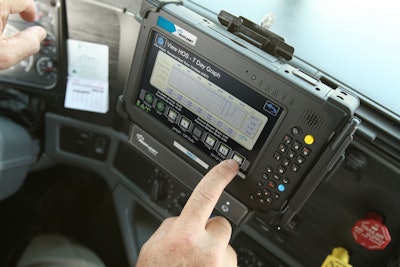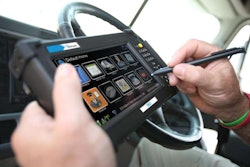Correction: An earlier version of this post incorrectly said the rule will not apply to drivers in vehicles “made in 2000 and after.” The rule will not apply to drivers in vehicles made before the year 2000. Another version also said the rule would take effect on Dec. 16, 2017. It in fact will take effect Dec. 16, 2017.
CCJ will continue to report on the ELD mandate’s publication, its stipulations and response from the industry this week and next.

A federal rule to require truck operators to use electronic logging devices to keep records of duty status is slated to be published in the Federal Register on Friday, the Federal Motor Carrier Safety Administration has announced. The rule will take effect Dec. 16, 2017, giving carriers and drivers a two-year window to comply with the rule’s requirements.
Upon beginning use of an ELD, drivers will no longer be required to keep and maintain paper logs. They will, however, be required to maintain supporting documentation and submit them to their carrier or, for owner-operators, keep them on file.
The rule requires drivers currently required to keep paper logs to use ELDs, with a few exceptions (see them below). The mandate, however, will not apply to drivers of vehicles built in the year 2000 and before — a change made from 2014’s proposed version of the rule.
The rule also spells out safeguards against driver harassment via the devices, hardware specifications of the devices and supporting documentation drivers must continue to keep after the mandate.
FMCSA says the rule will save the industry $1 billion a year, mostly in time and money saved on paperwork, the agency says. It also says the rule will “save 26 lives and 562 injuries” a year, the agency said in a press release.
Here’s a look at the mandate’s key components:
Mandating ELDs
The ELD mandate will apply to all drivers required to keep records of duty status, except drivers who (1) keep records of duty status in 8 or fewer days out of every 30 working days, (2) drivers in drive-away and tow-away operations and (3) truckers operating vehicles older than model year 2000.
The devices must be installed and in use by Dec. 16, 2017 — two years after its scheduled Dec. 11, 2015, publication date.
Device specifications
ELDs that meet the minimum standards spelled out in the rule will not be required to track a vehicle or a driver in real-time. They also will not be required to include driver-carrier communication capabilities.
They must, however, be able to automatically record date, time and location information; engine hours; vehicle miles; and ID information of the driver using the device.
The devices must sync with its corresponding vehicle’s engine to record engine on and off time.
The rule also requires compliant devices to be able to transfer data during roadside inspections “on-demand,” via either a wireless Web-based services, email, USB 2.0 or Bluetooth. The rule also stipulates that the ELDs “present a graph grid of a driver’s daily duty status changes either” on the units themselves or in printouts.
Supporting documents
Drivers, while not required to keep paper logs, still must keep a maximum of eight supporting documents, either electronic or paper, for every 24-hour period that includes on-duty time. They must submit these supporting documents to their carrier within 13 days of receiving them, and carriers must retain the documents — along with records of duty status — for six months.
Supporting documents include: (1) bills of lading, itineraries, schedules or other documents that show trip origin and destination, (2) dispatch records, trip records or similar documents (3) expense receipts, (4) electronic mobile communication records sent through fleet management systems or (5) payroll records, settlement sheets or similar documents that show what and how a driver was paid.
If a driver submits to a carrier more than eight documents for a 24-hour period, the carrier must keep the first and last document for the day and six others. If fewer than eight are submitted, carriers must retain all of them.
Harassment of drivers
A similar ELD-mandate set for implementation in 2012 was tossed in court over its lack of protection against driver harassment. In accordance with that, FMCSA’s new rule makes it illegal for carriers to use the devices to harass drivers, puts in place fines for doing so and puts in place a system for drivers to report such instances.
The rule defines harassment of drivers via an ELD as any action by a carrier toward a driver that the carrier “knew or should have known” would have interrupted a driver’s off-duty time. “Harassment must involve information available to the motor carrier through an ELD or other technology used in combination with and not separable from an ELD,” the rule states.
More on the rule’s driver harassment provisions will be posted later today.










